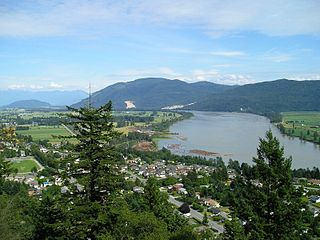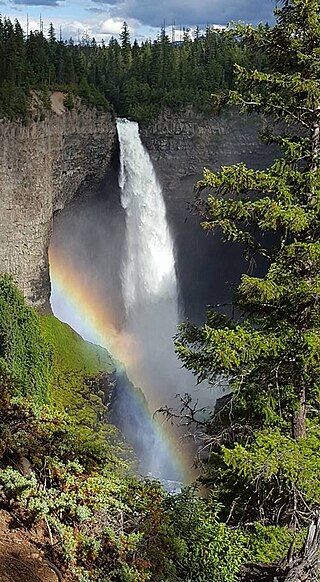Related Research Articles

The Fraser River is the longest river within British Columbia, Canada, rising at Fraser Pass near Blackrock Mountain in the Rocky Mountains and flowing for 1,375 kilometres (854 mi), into the Strait of Georgia just south of the City of Vancouver. The river's annual discharge at its mouth is 112 cubic kilometres (27 cu mi) or 3,550 cubic metres per second (125,000 cu ft/s), and each year it discharges about 20 million tons of sediment into the ocean.

Lions Bay is a small residential community in British Columbia, Canada, located between Vancouver and Squamish on the steep eastern shore of Howe Sound. In the 2021 census the community had a population of 1,390, BC's 36th smallest municipality by population. At 2.53 square kilometres (0.98 sq mi), it is BC's 10th smallest municipality by land area. Originally a boat-access summer camping destination for Vancouverites, Lions Bay began to be permanently settled in the 1960s. The community incorporated as a village municipality in January 1971.
Skookumchuck is in the East Kootenay region of southeastern British Columbia. This locality straddles both shores of the Kootenay River north of the mouth of the Lussier River. The crossing, on the merged section of highways 93 and 95, is by road about 54 kilometres (34 mi) north of Cranbrook and 193 kilometres (120 mi) southeast of Golden.
Spuzzum is an unincorporated community in the lower Fraser Canyon area of southwestern British Columbia, Canada. The place is on the west shore of the Fraser River and north shore of Spuzzum Creek. The locality, on BC Highway 1, is by road about 40 kilometres (25 mi) north of Hope and 69 kilometres (43 mi) south of Lytton.
Hedley is an unincorporated community near the mouth of Hedley Creek in the Similkameen region of southern British Columbia. The former mining town, on BC Highway 3, is by road about 74 kilometres (46 mi) southwest of Penticton and 38 kilometres (24 mi) southeast of Princeton.

The Los Angeles flood of 1938 was one of the largest floods in the history of Los Angeles, Orange, and Riverside Counties in southern California. The flood was caused by two Pacific storms that swept across the Los Angeles Basin in February-March 1938 and generated almost one year's worth of precipitation in just a few days. Between 113–115 people were killed by the flooding. The Los Angeles, San Gabriel, and Santa Ana Rivers burst their banks, inundating much of the coastal plain, the San Fernando and San Gabriel Valleys, and the Inland Empire. Flood control structures spared parts of Los Angeles County from destruction, while Orange and Riverside Counties experienced more damage.

Fort Steele is a heritage site in the East Kootenay region of southeastern British Columbia. This visitor attraction lies on the east shore of the Kootenay River between the mouths of the St. Mary River and Wild Horse River. The locality, on the merged section of highways 93 and 95, is by road about 17 kilometres (11 mi) northeast of Cranbrook and 230 kilometres (143 mi) southeast of Golden.

The Coldwater River is in south central British Columbia, Canada. The river is the largest tributary of the Nicola River, which is joined at Merritt.
Alexandria or Fort Alexandria was a general area encompassing a trading post, ferry site, and steamboat landing in the North Cariboo region of central British Columbia. The present unincorporated community is on the eastern side of the Fraser River. On BC Highway 97, the locality is by road about 74 kilometres (46 mi) northwest of Williams Lake and 45 kilometres (28 mi) south of Quesnel.
The Duncan River is in the West Kootenay region of southeastern British Columbia. Entering the North Arm of Kootenay Lake, the river is a major tributary of the Kootenay River, which in turn flows into the Columbia River. The Selkirk Mountains lie to the west and the Purcell Mountains to the east.
Australian is an unincorporated community on the east side of the Fraser River in the North Cariboo region of central British Columbia. On BC Highway 97, the locality is by road about 85 kilometres (53 mi) north of Williams Lake and 33 kilometres (21 mi) south of Quesnel.

Rock Creek is a settlement in the Boundary Country region of south central British Columbia. The unincorporated settlement is mostly on the southwest side of the Kettle River at the confluence with Rock Creek. The place lies at the junction of BC Highway 33, and BC Highway 3.
Deroche is an unincorporated community at the foot of Nicomen Mountain in the Fraser Valley region of southwestern British Columbia. Encompassing the northeastern part of Nicomen Island, the infrastructure is centred on the northern shore of Nicomen Slough. The locality, on BC Highway 7, is by road about 29 kilometres (18 mi) west of Agassiz, 89 kilometres (55 mi) east of Vancouver, and 21 kilometres (13 mi) east of Mission.

Mara Lake is a lake in the Shuswap Country region of south central British Columbia, Canada. To the west is Hyde Mountain and east is Morton Peak. The outlet of the Shuswap River forms the upper reaches. The lower end enters the narrows at Sicamous and flows into Shuswap Lake. The northern end of Mara Lake is by road about 73 kilometres (45 mi) west of Revelstoke, 140 kilometres (87 mi) east of Kamloops, and 75 kilometres (47 mi) north of Vernon.
Wasa is an unincorporated community in the East Kootenay region of southeastern British Columbia. This place, on the east shore of the Kootenay River north of the mouth of Lewis Creek, surrounds Wasa Lake. The locality, on the merged section of highways 93 and 95, is by road about 36 kilometres (22 mi) north of Cranbrook and 211 kilometres (131 mi) southeast of Golden.

The Germansen River is in the Omineca region of central British Columbia, Canada. Flowing through Germansen Lake, the river is a major tributary of the Omenica River, which in turn enters Williston Lake. Surrounded by the spread of the Swannell Ranges, the lake is south of Plughat Mountain and north of the Germansen Range, which contains Mount Germansen.

Wells Gray Provincial Park is a large wilderness park located in east-central British Columbia, Canada. The park protects most of the southern, and highest, regions of the Cariboo Mountains and covers 5,415 square kilometres. It is British Columbia's fifth largest provincial park, after Tweedsmuir, Tatshenshini, Spatsizi and Northern Rocky Mountains.
The Lardeau River, which flows into the Duncan River, is in the West Kootenay region of southeastern British Columbia. The Selkirk Mountains lie to the west and the Purcell Mountains to the east.
Waldo is a ghost town in the East Kootenay region of southeastern British Columbia. About 2 kilometres (1.2 mi) north of Krag, the remnants are submerged beside the east shore of Lake Koocanusa, just north of the mouth of the Elk River. Off BC Highway 93, the site is by road about 69 kilometres (43 mi) southwest of Cranbrook and 48 kilometres (30 mi) southeast of Fernie.
Downie Creek is in the West Kootenay region of southeastern British Columbia, Canada. Surrounded by the Selkirk Mountains, the creek is a tributary of Lake Revelstoke, part of the Columbia River. On BC Highway 23, the highway bridge is by road about 69 kilometres (43 mi) north of Revelstoke.
References
- ↑ BC Names/GeoBC entry "M (Yahoo) Creek"
- ↑ BC Names/GeoBC entry "M Creek (rescinded)"
- ↑ Debris supply to torrent-prone channels on the east side of Howe Sound, Bruce Ronald Dagg, UBC Master's thesis, 1981, p. 71
- ↑ Debris supply to torrent-prone channels on the east side of Howe Sound, Bruce Ronald Dagg, UBC Master's thesis, 1981, p. 74
- ↑ Debris supply to torrent-prone channels on the east side of Howe Sound, Bruce Ronald Dagg, UBC Master's thesis, 1981, p. 12
- ↑ Geography of British Columbia, Third Edition: People and Landscapes in Transition, Brett McGillivray, UBC Press, 2011, p. 60
- ↑ A Look Back In Time: Fifteen years ago this week, Mary Billy, Squamish Chief newspaper, Squamish Library archives, 17 December 1996
- ↑ Debris supply to torrent-prone channels on the east side of Howe Sound, Bruce Ronald Dagg, UBC Master's thesis, 1981, p. 74
- ↑ Debris supply to torrent-prone channels on the east side of Howe Sound, Bruce Ronald Dagg, UBC Master's thesis, 1981, p. 13
- ↑ Renewed calls for bridge warning system, Alison Taylor, Pique Newsmagazine, Oct 24, 2003